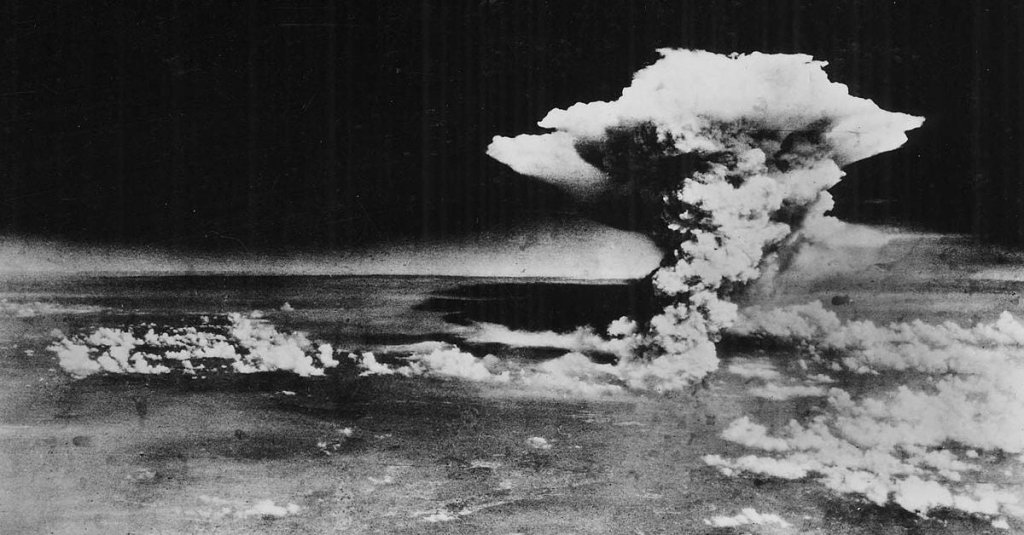

On Aug. 6, 1945, the United States dropped the world’s first atomic bomb over the city of Hiroshima.
U.S. President Harry Truman decided to use the atom bomb to force an unconditional surrender from Japan. At 8:16 AM on Aug. 6, the B-29 bomber Enola Gay (named for her pilot’s mother) dropped the bomb known as “Little Boy” over Hiroshima, killing 80,000 people instantly and another 60,000 over the following weeks from the effects of the fallout.

Hiroshima was selected as a target to deliberately demonstrate the power of the weapon by causing the most physical destruction but also as a psychological attack against the people and decision-makers of Japan.
The blast was so intense, human shadows are marked permanently on the ground and walls left standing. Radiation poisoning caused a significant number of deaths in the weeks following the bombings of Hiroshima and Nagasaki. The effects of radiation are varied, ranging from milder symptoms like gastrointestinal distress, fever, headaches and hair loss, but up to and including death. Because radiation can cause a drop in the number of blood cells produced, wounds heal more slowly than normal.
The effects were devastating but it would take a second atomic bomb dropped on Nagasaki several days later before Emperor Hirohito finally surrendered, ending World War II.

The pilot of the Enola Gay, Paul Tibbets, died in January 2007, after having retired from the Air Force in 1966. Instead of being interred at home or at Arlington National Cemetery with all his brothers in arms, he was cremated and his ashes spread across the English Channel. The elder Tibbets was concerned that any grave or headstone he left behind would become ground zero for anti-nuclear weapons protests, anti-war protesters or a place for any other kind of revision historian to make a stand against what he saw as the right history. Instead of that, he opted to be cremated and his ashes spread where he had flown so often during the war. There were many survivor accounts of Hiroshima, such as “August 6,” written by Toge Sankichi:
August 6
By: TŌGE Sankichi, translated by Karen Thornber
can we forget that flash?
suddenly 30,000 in the streets disappeared
in the crushed depths of darkness
the shrieks of 50,000 died out
when the swirling yellow smoke thinned
buildings split, bridges collapsed
packed trains rested singed
and a shoreless accumulation of rubble and embers – Hiroshima
before long, a line of naked bodies walking in groups, crying
with skin hanging down like rags
hands on chests
stamping on crumbled brain matter
burnt clothing covering hips
corpses lie on the parade ground like stone images of Jizo, dispersed in all
directions
on the banks of the river, lying one on top of another, a group that had crawled to
a tethered raft
also gradually transformed into corpses beneath the sun’s scorching rays
and in the light of the flames that pierced the evening sky
the place where mother and younger brother were pinned under alive
also was engulfed in flames
and when the morning sun shone on a group of high-school girls
who had fled and were lying
on the floor of the armory, in excrement
their bellies swollen, one eye crushed, half their bodies raw flesh with skin ripped
off, hairless, impossible to tell who was who
all had stopped moving
in a stagnant, offensive smell
the only sound the wings of flies buzzing around metal basins
city of 300,000
can we forget that silence?
in that stillness
the powerful appeal
of the white eye sockets of the wives and children who did not return home
that tore apart our hearts
can it be forgotten?!
TŌGE Sankichi (1917 – 1953) was a Japanese poet, activist and survivor of the atomic bombing of Hiroshima. His collection “Poems of the Atomic Bomb” was published in 1951. Karen Thornber is a recipient of the 2011 Sibley Prize from the University of Chicago for her translation of that collection.
Featured Image: An atomic cloud rises over Hiroshima after the bomb is dropped. (509th Operations Group)
